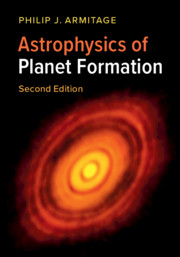Crossref Citations
This Book has been
cited by the following publications. This list is generated based on data provided by Crossref.
Peña, J.
Fuentes, C.
Förster, F.
Martínez-Palomera, J.
Cabrera-Vives, G.
Maureira, J. C.
Huijse, P.
Estévez, P. A.
Galbany, L.
González-Gaitán, S.
and
Jaeger, Th. de
2020.
Asteroids’ Size Distribution and Colors from HITS.
The Astronomical Journal,
Vol. 159,
Issue. 4,
p.
148.
Peng, Shirui
and
Batygin, Konstantin
2020.
Interactions among Noninteracting Particles in Planet Formation Simulations.
The Astrophysical Journal Letters,
Vol. 898,
Issue. 2,
p.
L46.
Longarini, Cristiano
Lodato, Giuseppe
Toci, Claudia
and
Aly, Hossam
2021.
Dynamical dust traps in misaligned circumbinary discs: analytical theory and numerical simulations.
Monthly Notices of the Royal Astronomical Society,
Vol. 503,
Issue. 4,
p.
4930.
Ravichandran, S.
and
Wettlaufer, J.S.
2021.
Melting driven by rotating Rayleigh–Bénard convection.
Journal of Fluid Mechanics,
Vol. 916,
Issue. ,
Shahamat, Narjes
Abbassi, Shaharam
and
Liu, Tong
2021.
GRB variabilities and following gravitational waves induced by gravitational instability in NDAFs.
Monthly Notices of the Royal Astronomical Society,
Vol. 508,
Issue. 4,
p.
6068.
Williams, Jonathan P.
and
Hogerheijde, Michiel R.
2021.
Encyclopedia of Astrobiology.
p.
1.
Prettyman, Thomas
Sanctis, Maria Cristina De
and
Marchi, Simone
2022.
Vesta and Ceres.
p.
121.
Kajtazi, Kaltrina
Petit, Antoine C.
and
Johansen, Anders
2023.
Mean motion resonance capture in the context of type I migration.
Astronomy & Astrophysics,
Vol. 669,
Issue. ,
p.
A44.
Tuna, Semih
and
Metzger, Brian D.
2023.
Long-term Evolution of Massive-star Post-common-envelope Circumbinary Disks and the Environments of Fast Luminous Transients.
The Astrophysical Journal,
Vol. 955,
Issue. 2,
p.
125.
Williams, Jonathan P.
and
Hogerheijde, Michiel R.
2023.
Encyclopedia of Astrobiology.
p.
2493.
Gianuzzi, Emmanuel
Giuppone, Cristian
and
Cuello, Nicolás
2023.
Circumbinary planets: migration, trapping in mean-motion resonances, and ejection.
Astronomy & Astrophysics,
Vol. 669,
Issue. ,
p.
A123.
Rucska, J J
and
Wadsley, J W
2023.
Planetesimal formation via the streaming instability with multiple grain sizes.
Monthly Notices of the Royal Astronomical Society,
Vol. 526,
Issue. 2,
p.
1757.
Jinno, Tenri
Saitoh, Takayuki R
Ishigaki, Yota
and
Makino, Junichiro
2023.
N-body simulation of planetary formation through pebble accretion in a radially structured protoplanetary disk.
Publications of the Astronomical Society of Japan,
Vol. 75,
Issue. 5,
p.
951.
Cohen, Ofer
Garraffo, Cecilia
Drake, Jeremy J.
Monsch, Kristina
Sokolov, Igor V.
Alvarado-Gómez, Julián D.
and
Fraschetti, Federico
2023.
Three-dimensional, Time-dependent MHD Simulation of Disk–Magnetosphere–Stellar Wind Interaction in a T Tauri, Protoplanetary System.
The Astrophysical Journal,
Vol. 949,
Issue. 2,
p.
54.
Mousavi-Sadr, M
Jassur, D M
and
Gozaliasl, G
2023.
Revisiting mass–radius relationships for exoplanet populations: a machine learning insight.
Monthly Notices of the Royal Astronomical Society,
Vol. 525,
Issue. 3,
p.
3469.
Maraboli, Enrico
Mantegazza, Fabio
and
Lodato, Giuseppe
2023.
Encounters in star clusters and survival probabilities for planets.
The European Physical Journal Plus,
Vol. 138,
Issue. 2,
Batygin, Konstantin
Adams, Fred C.
and
Becker, Juliette
2023.
The Origin of Universality in the Inner Edges of Planetary Systems.
The Astrophysical Journal Letters,
Vol. 951,
Issue. 1,
p.
L19.





